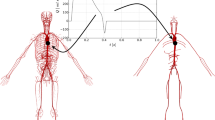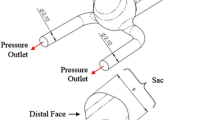Abstract
We compare results from numerical simulations of pulsatile blood flow in two patient-specific intracranial arterial networks using one-dimensional (1D) and three-dimensional (3D) models. Specifically, we focus on the pressure and flowrate distribution at different segments of the network computed by the two models. Results obtained with 1D and 3D models with rigid walls show good agreement in massflow distribution at tens of arterial junctions and also in pressure drop along the arteries. The 3D simulations with the rigid walls predict higher amplitude of the flowrate and pressure temporal oscillations than the 1D simulations with compliant walls at various segments even for small time-variations in the arterial cross-sectional areas. Sensitivity of the flow and pressure with respect to variation in the elasticity parameters is investigated with the 1D model.








Similar content being viewed by others
References
Alastruey, J., S. M. Moore, K. H. Parker, J. Peiró, T. David, and S. J. Sherwin. Reduced modeling of blood flow in the cerebral circulation: coupling 1-D, 0-D and cerebral auto-regulation models. Int. J. Numer. Methods Fluids 56(8):1061–1067, 2007.
Alastruey, J., K. H. Parker, J. Peiró, S. M. Byrd, and S. J. Sherwin. Modeling of circle of Willis to assess the effects of anatomical variations and inclusions on cerebral flows. J. Biomech. 40:1794–1805, 2007.
Cassot, F., M. Zagzoule, and J. P. Marc-Vergnes. Hemodynamic role of the circle of Willis in stenoses of internal carotid arteries. An analytical solution of a linear model. J. Biomech. 33:395–405, 2000.
Chen, J., and X. Y. Lu. Numerical investigation of the non-Newtonian pulsatile blood flow in a bifurcation model with a non-planar branch. J. Biomech. 39(5):818–832, 2006.
Chen, J., X. Lu, and W. Wang. Non-Newtonian effects of blood flow on hemodynamics in distal vascular graft anastomoses. J. Biomech. 39(11):1983–1995, 2006.
Das, B., P. Johnson, and A. Popel. Computational fluid dynamic studies of leukocyte adhesion effects on non-Newtonian blood flow through microvessels. Biorheology 37:239–258, 2000.
Fahrig, R., H. Nikolov, A. J. Fox, and D. W. Holdsworth. A three dimensional cerebrovascular flow phantom. Med. Phys. 26:1589–1599, 1999.
Frahm, J., A. Haase, and D. Matthaei. Rapid NMR imaging of dynamic processes using the FLASH technique. Magn. Reson. Med. 3:321–327, 1986.
Fontanella, M. M., W. Valfré, F. Benech, C. Carlino, D. Garbossa, M. F. Ferrio, R. Perez, M. Berardino, G. B. Bradac, and A. Ducati. Vasospasm after SAH due to aneurysm rupture of the anterior circle of Willis: value of TCD monitoring. Neurol. Res. 30(3):256, 2008.
Formaggia, L., D. Lamponi, M. Tuveri, and A. Veneziani. Numerical modeling of 1D arterial networks coupled with a lumped parameters description of the heart. Comput. Methods Biomech. Biomed. Eng. 9(5):273–288, 2006.
Gonzalez, N. R., W. J. Boscardin, T. Glenn, F. Vinuela, and N. A. Martin. Vasospasm probability index: a combination of transcranial Doppler velocities, cerebral blood flow, and clinical risk factors to predict cerebral vasospasm after aneurysmal subarachnoid hemorrhage. J. Neurosur. 107(6):1101–1112, 2007.
Greitz, D. Cerebrospinal fluid circulation and associated intracranial dynamics. A radiologic investigation using MR imaging and radionuclide cisternography. Acta Radiol. Suppl. 386:1–23, 1993.
Grinberg, L. Topics in Ultrascale Scientific Computing with Application in Biomedical Modeling. PhD thesis, Brown University, 2009.
Grinberg, L., T. Anor, E. Cheever, J. Madsen, and G. E. Karniadakis. Simulation of the human intracranial arterial tree. Philos. Trans. R. Soc. A 367(1896):2371–2386, 2009.
Grinberg, L., and G. E. Karniadakis. Outflow boundary conditions for arterial networks with multiple outlets. Ann. Biomed. Eng. 36(9):1496–1514, 2008.
Grinberg, L., and G. E. Karniadakis. A new domain decomposition method with overlapping patches for ultrascale simulations: application to biological flows. J. Comput. Phys. 229:5541–5563, 2010.
Huo, Y., J. S. Choy, M. Svendsen, A. K. Sinha, and G. S. Kassab. Effects of vessel compliance on flow pattern in porcine epicardial right coronary arterial tree. J. Biomech. 42:594–602, 2009.
Isaksen, J. G., Y. Bazilevs, T. Kvamsdal, Y. Zhang, J. H. Kaspersen, K. Waterloo, B. Romner, and T. Ingebrigtsen. Determination of wall tension in cerebral artery aneurysms by numerical simulation. Stroke 39(12):3172–3178, 2008.
Kim C.S., C. Kiris, and D. Kwak. Numerical models of human circulatory system under altered gravity: brain circulation. AIAA Paper No. 2004-1092, AIAA 42nd Aerospace Sciences Meeting and Exhibit, Reno, NV, January 2004.
Ku, D. N. Blood flow in arteries. Annu. Rev. Fluid Mech. 29:399–434, 1997.
Lee, S. W., L. Antiga, J. D. Spence, and D. A. Steinman. Geometry of the carotid bifurcation predicts its exposure to disturbed flow. Stroke 39(8):2341–2347, 2008.
Matthys, K. S., J. Alastruey, J. Peiró, A. W. Khir, P. Segers, P. R. Verdonck, K. H. Parker, and S. J. Sherwin. Pulse wave propagation in a model human arterial network: assessment of 1D numerical simulations against in-vitro measurements. J. Biomech. 40(15):3476–3486, 2007.
Moore, S. M., K. T. Moorhead, J. G. Chase, T. David, and J. Fink. One-dimensional and three-dimensional models of cerebrovascular flow. J. Biomech. Eng. 127(3):440–449, 2005.
Olufsen, M. S. Structured tree outflow condition for blood flow in larger systemic arteries. Am. J. Physiol. 276:H257–H268, 1999.
Perktold, K., and G. Rappitsch. Computer simulation of local blood flow and vessel mechanics in a compliant carotid artery bifurcation model. J. Biomech. 28(7):845–856, 1995.
Reymond, P., F. Merenda, F. Perren, D. Rufenacht, and N. Stergiopulos. Validation of a one-dimensional model of the systematic arterial tree. Am. J.Physiol. Heart Circ. Physiol. 297:208–222, 2009.
Sherwin, S. J., V. Franke, J. Peiró, and K. Parker. 1D modeling of a vascular network in space-time variable. J. Eng. Math. 47:217–250, 2003.
Sherwin, S. J., and G. E. Karniadakis. Spectral/hp Element Methods for CFD, 2nd ed. Oxford: Oxford University Press, 2005.
Smith, N. P., A. J. Pullan, and P.J. Hunter. An anatomically based model of transient coronary blood flow in the heart. SIAM J. Appl. Math. 62:990–1018, 2001.
Spilker, R., J. Feinstein, D. Parker, V. Reddy, and C. Taylor. Morphometry-based impedance boundary conditions for patient-specific modeling of blood flow in pulmonary arteries. Ann. Biomed. Eng. 35(4):546–559, 2007.
Stanfield, C. L. Principles of Human Physiology. San Francisco, CA: Benjamin Cummings, 2008.
Stergiopulos, N., D. Young, and T. Rogge. Computer simulation of arterial flow with applications to arterial and aortic stenoses. J. Biomech. 25:1477–1488, 1992.
Taylor, C. A., and M. T. Draney. Experimental and computational methods in cardiovascular fluid mechanics. Annu. Rev. Fluid Mech. 36:197–231, 2004.
White, H., and B. Venkatesh. Applications of transcranial Doppler in the ICU: a review. Intensive Care Med. 32(7):981–994, 2007.
Xiu, D. B., and J. S. Hesthaven. High order collocation methods for differential equations with random inputs. SIAM J. Sci. Comput. 27(3):1118–1139, 2005.
Xiu, D. B., and G. E. Karniadakis. The Wiener-Askey polynomial chaos for stochastic differential equations. SIAM J. Sci. Comput. 24(2):619–644, 2002.
Xiu, D. B., and S. J. Sherwin. Parametric uncertainty analysis of pulse wave propagation in a model of a human arterial network. J. Comput. Phys. 226:1385–1407, 2007.
Acknowledgments
This study was supported by the NSF under Grants OCI-0636336 and NSF OCI-0904288. T. Anor and J. R. Madsen would like to thank the Webster Family for supporting their study. Supercomputer resources were provided by the National Institute for Computational Sciences at University of Tennessee.
Author information
Authors and Affiliations
Corresponding author
Additional information
Associate Editor Aleksander S. Popel oversaw the review of this article.
Rights and permissions
About this article
Cite this article
Grinberg, L., Cheever, E., Anor, T. et al. Modeling Blood Flow Circulation in Intracranial Arterial Networks: A Comparative 3D/1D Simulation Study. Ann Biomed Eng 39, 297–309 (2011). https://doi.org/10.1007/s10439-010-0132-1
Received:
Accepted:
Published:
Issue Date:
DOI: https://doi.org/10.1007/s10439-010-0132-1




